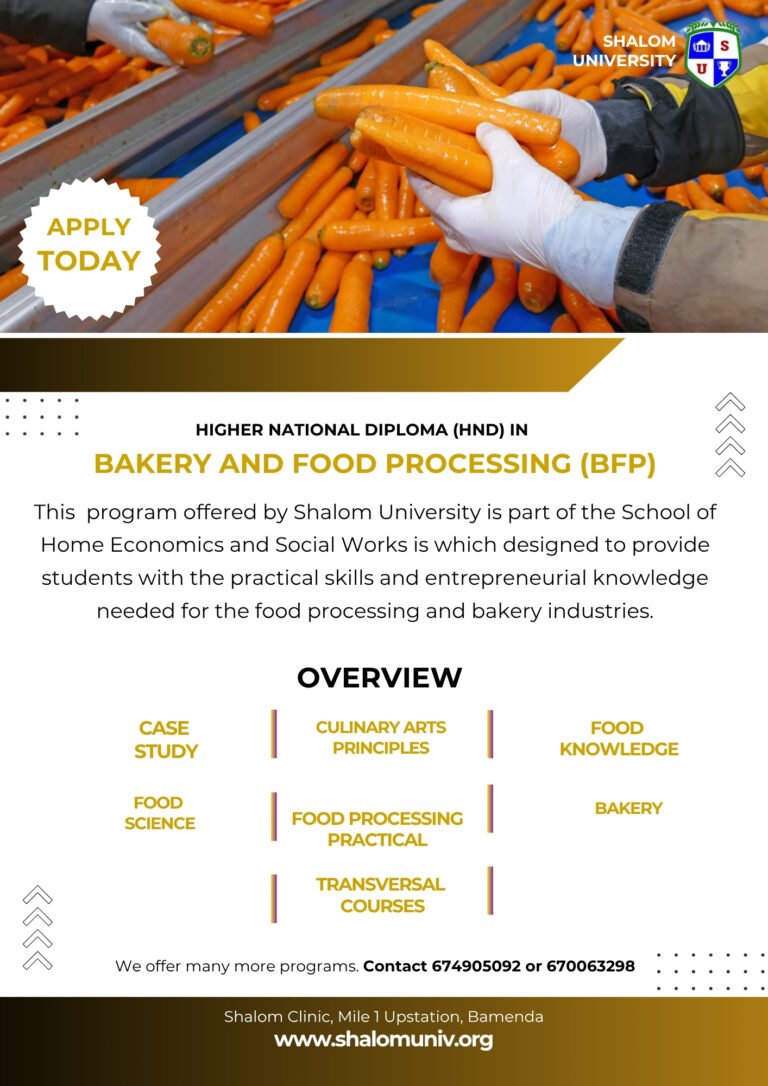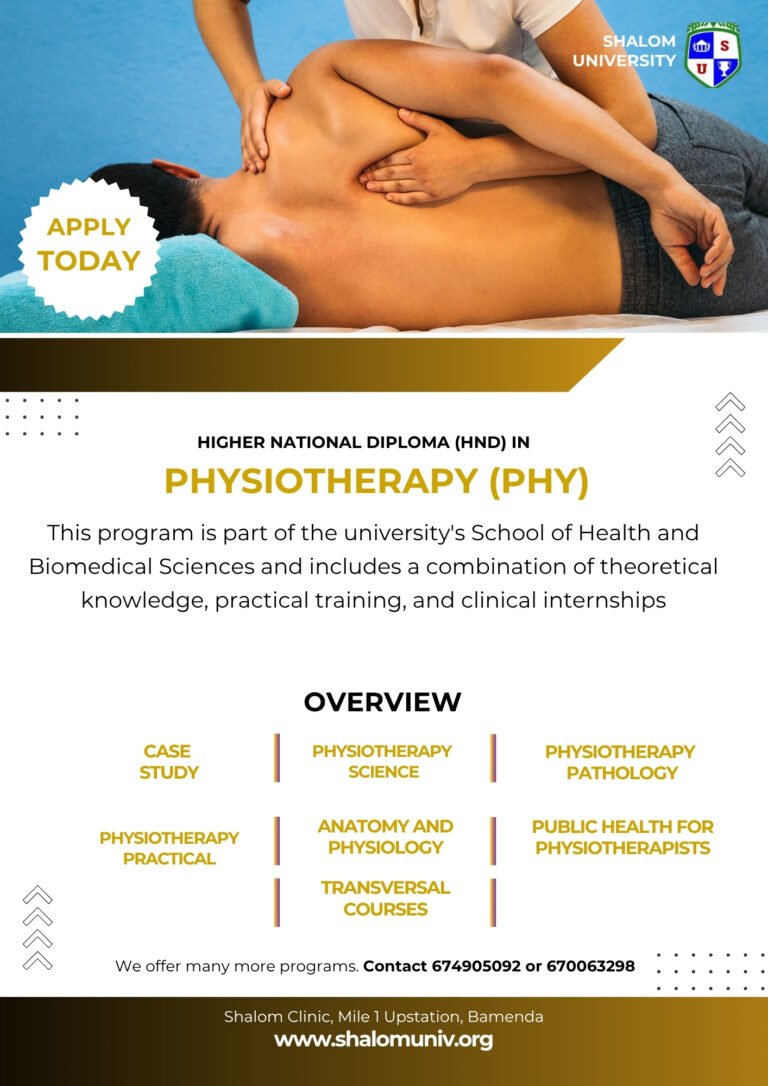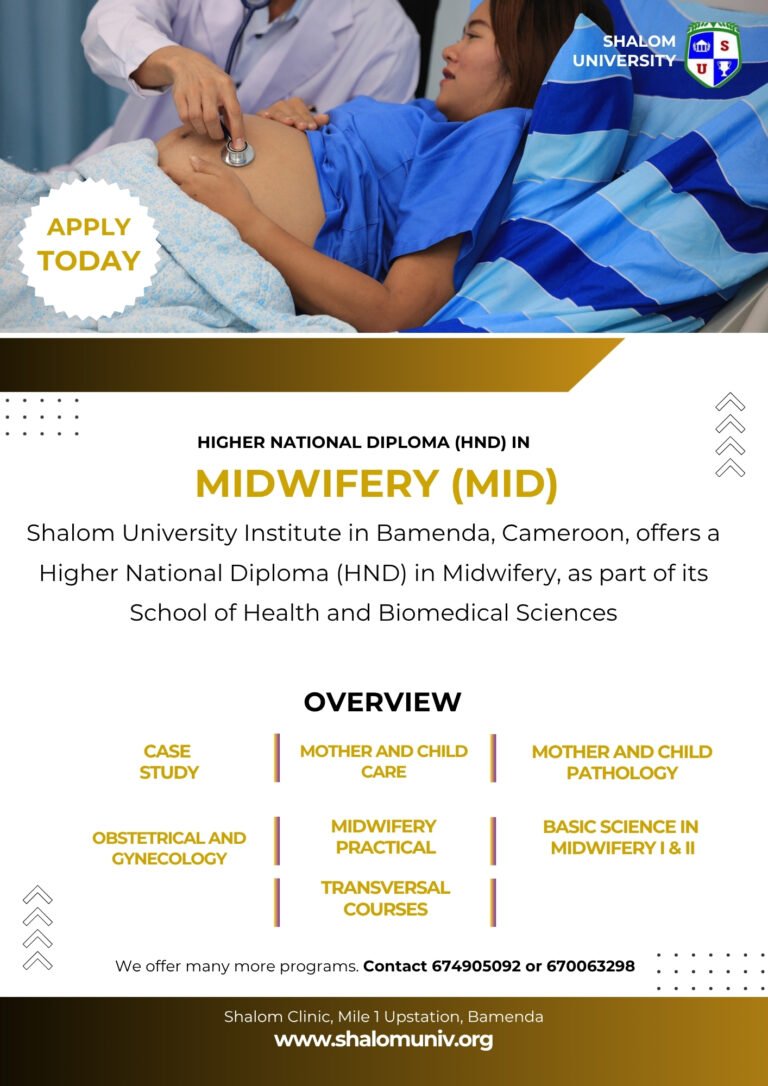In Cameroon, where access to specialized eye care is often a challenge, skilled professionals in clinical optometry play a crucial role in preventing blindness and correcting vision problems. The HND in Optician/Clinical Optometry (OPT) at Shalom University in Bamenda offers a comprehensive program designed to train the next generation of eye care experts. This program combines rigorous scientific principles with practical, hands-on training, preparing graduates to address the unique eye health needs of the Cameroonian population.
The curriculum at Shalom University is specifically tailored to equip students with the essential knowledge and skills to combat low vision and avoidable blindness, which remains a significant public health burden in Cameroon. The program focuses on developing a well-rounded professional capable of handling a range of visual defects and administering emergency eye care.
The OPT Curriculum at Shalom University
The HND in Optician/Clinical Optometry program at Shalom University is built on a series of core papers that progressively build a student’s expertise.
Paper: Anatomy and Physiology
This foundational course provides a broad understanding of the human body’s systems, which is crucial for contextualizing eye health within a person’s overall physical condition. Many systemic diseases, such as diabetes and hypertension, have ocular manifestations, and this paper helps students recognize these connections.
Key topics include:
- Systemic Body Systems: An overview of the major body systems (cardiovascular, nervous, endocrine) and their functions.
- Pathophysiology: How systemic diseases affect various parts of the body and how these effects can present in the eyes.
- Clinical Relevance: The link between general health and ocular health, enabling students to identify red flags that may require a referral to a general practitioner.
Paper: Ocular Anatomy and Physiology
This paper is a specialized deep dive into the structure and function of the eyes and the surrounding visual system. A thorough knowledge of ocular anatomy and physiology is the bedrock of clinical optometry, as it provides the basis for understanding healthy vision and diagnosing pathology.
The curriculum covers:
- The Globe and Adnexa: Detailed study of the eyeball’s internal and external structures, including the cornea, lens, retina, and the protective tissues around the eye.
- Visual Pathways: Tracing the neural pathways from the retina to the brain, which is essential for understanding how visual information is processed.
- Ocular Function: The physiological processes of vision, including focusing, light perception, and eye movement.
Paper: Optometry Science
Optometry Science covers the theoretical principles and scientific basis of optical instruments and vision correction. This paper is key to understanding the science behind prescribing and dispensing corrective lenses.
Topics include:
- Geometrical and Physical Optics: The behavior of light and its interaction with lenses and mirrors, which is fundamental to understanding corrective eyewear.
- Visual Optics: The application of optical principles to the human eye, including how refractive errors like myopia (nearsightedness), hyperopia (farsightedness), and astigmatism occur.
- Lens Technology: The properties and designs of various types of lenses, including single vision, multifocal, and high-index lenses.
Paper: Optometry Pathology
This paper focuses on the identification, diagnosis, and management of eye diseases and conditions. Given the prevalence of common eye diseases like glaucoma and cataracts in Cameroon, this paper is vital for training competent clinical optometrists.
The curriculum addresses:
- Common Eye Diseases: The clinical features, diagnosis, and management of prevalent conditions such as glaucoma, cataracts, allergic conjunctivitis, and uveitis, as noted by ophthalmic nurses working in Bamenda.
- Systemic Diseases and Eye Health: The ocular manifestations of systemic diseases, including diabetes and hypertension, enabling early detection and management.
- Low Vision and Blindness: Understanding the causes of low vision and blindness and the strategies for managing patients with significant visual impairment.
Paper: Public Health for Eyecare
Public health is a crucial aspect of healthcare in Cameroon, where resources can be limited and access to care is not universal. This paper prepares students to address eye health on a broader, community-wide scale.
Topics include:
- Epidemiology of Eye Diseases: The study of the distribution and determinants of eye diseases in the Cameroonian population.
- Community Eye Care Initiatives: Designing and implementing programs to promote eye health and provide screenings in schools and communities.
- Health Promotion and Education: Educating the public on the importance of regular eye examinations, proper hygiene, and seeking timely treatment.
- Collaboration with NGOs: Working with non-governmental organizations (NGOs) and public health bodies to expand access to eye care services, particularly in underserved rural areas.
Paper: Optometry Practical
This is the hands-on component of the program, where students gain the practical skills needed to conduct thorough eye examinations, use optometric equipment, and dispense eyewear. This paper often includes supervised clinical attachments in local eye clinics or hospitals.
The practical training includes:
- Refraction Techniques: Mastering both objective and subjective refraction to determine the precise prescription for a patient’s corrective lenses.
- Diagnostic Instruments: Proficiency in using key instruments such as the ophthalmoscope, retinoscope, slit lamp, and tonometer for comprehensive eye exams.
- Eyewear Dispensing: Learning to fit, adjust, and repair glasses, and advising patients on the best frame and lens options for their needs.
- Patient Communication: Developing effective communication skills for history taking, counseling patients on their diagnosis, and explaining treatment options.
Paper: Case Study
The Case Study paper is a vital component that integrates all the theoretical and practical knowledge gained throughout the program. It challenges students to analyze comprehensive patient scenarios, from initial diagnosis to treatment planning and follow-up. This is particularly relevant for optometrists in Cameroon, who are often required to make independent clinical judgments within their scope of practice.
The course trains students to:
- Develop a comprehensive treatment plan: Based on a given patient case, students must devise a complete treatment plan that addresses all diagnosed oral health issues.
- Consider all factors: Students must consider patient-specific factors, such as age, medical history, socioeconomic status, and access to care, which are all significant in the Cameroonian context.
- Defend their decisions: During formal presentations, students must justify their diagnostic and treatment choices, demonstrating their clinical reasoning and critical thinking skills.
- Reflect on professional practice: The process encourages students to reflect on their skills, communication strategies, and ethical responsibilities.
A Vision for the Future
Graduates of the HND in Optician/Clinical Optometry from Shalom University are well-prepared to serve the Cameroonian community. They possess the skills to perform comprehensive eye examinations, diagnose common eye conditions, and dispense corrective eyewear, playing a key role in public health. The program’s blend of theoretical knowledge, practical training, and community focus ensures that graduates are not only clinically competent but also equipped to address the unique eye health challenges facing the nation. By providing quality training in this critical field, Shalom University significantly contributes to improving vision and overall quality of life for countless Cameroonians.




